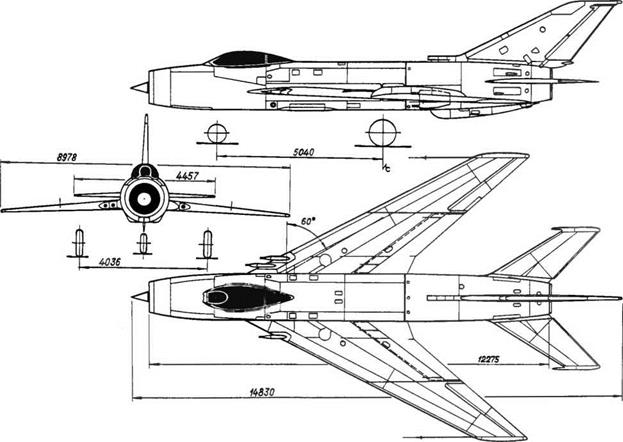1-380 /1-3
The 1-3 was a logical follow-on for the 1-1/1-2 design philosophy among various single-engine fighters developed simultaneously with other types such as the MiG-19 that were already being mass-produced Its design and structure were based on standard concepts shared by most other fighters of that time – all-metal structure, highly swept (over 50 degrees) and lift-augmented wing, airbrakes plus tail chute, powerful reheated turbojets, ejection seat, flying controls with artificial feel and gear ratio on the pitch channel, all-purpose on-board systems, and heavy armament (cannons)
The preliminary design of the 1-3 (1-380) frontline fighter, mapped out around the new Klimov VK-3 turbojet, was completed in March 1954 The VK-3 possessed an axial flow compressor, an annular combustion chamber, and an afterburner It was rated at 5,615 daN (5,730
|

kg st) of design nominal thrust and 8,270 daN (8,440 kg st) with afterburner. The I-3’s stabilator and aileron power units were of the irreversible type. On the other hand, the rudder servo-control units were reversible. The wing had a sweepback of 60 degrees С/4. The airbrakes covered an area of 1.2 m2 (12.9 square feet) and flanked the fuselage just behind the wing root. Their role was not only to shorten the landing roll and to improve the aircraft’s handling in level flight but also to reduce the aircraft’s speed during a full-power vertical dive. The PT 2165-511 tail chute was 15 m2 (161.5 square feet) in area. Armament consisted of three NR-30 cannons, two on the right and one on the left in the leading edge near the wing root. The pilot was protected by a 65- mm-tbick bulletproof windshield, a 10-mm armor plate in front of the cockpit, and a 16-mm armor plate in the seat back and headrest. Development of the turbojet was delayed several times by technical problems; as it turned out, the 1-3 was never powered by the VK-3 and was later converted into an 1-3U.
Specifications
Span, 8.978 m (29 ft 5.5 in); overall length, 14.83 m (48 ft 0.8 in); fuselage length (except cone), 12.275 m (40 ft 3.3 in); wheel track, 4.036 m (13 ft 2.9 in); wheel base, 5.04 m (16 ft 6.4 in); wing area, 30 m2 (322.9 sq ft); empty weight, 5,485 kg (12,090 lb); takeoff weight, 7,600 kg (16,750 lb); max takeoff weight, 8,954 kg (19,735 lb); fuel, 1,800 kg (3,970 lb); oil, 32 kg (70 lb); wing loading, 253.3-298.5 kg/m2 (51.9-61.2 Ib/sq ft); max operating limit load factor, 9.
Performance
Max speed, 1,274 km/h (688 kt) at sea level; 1,311 km/h at 5,000 m (708 kt at 16,400 ft); 1,775 km/h at 10,000 m (958 kt at 32,800 ft); climb to 5,000 m (16,400 ft) in 0.81 min; to 10,000 m (32,800 ft) in 1.9 min; service ceiling, 18,800 m (61,660 ft); landing speed, 190 km/h (103 kt); endurance, 1 h 46 min; range, 1,365 km (848 mi); takeoff roll, 390 m (1,280 ft); landing roll, 726 m (2,380 ft).










